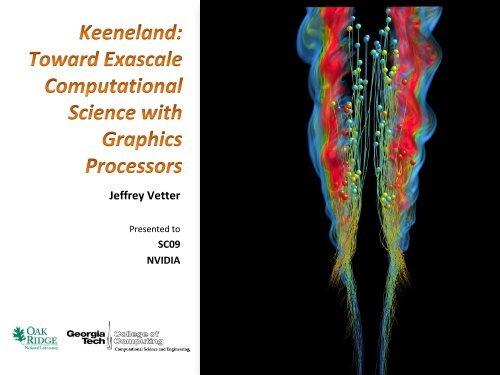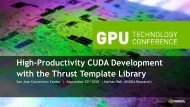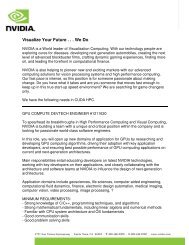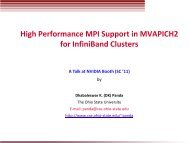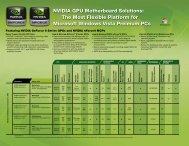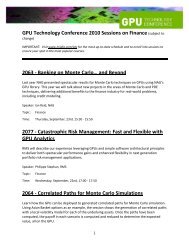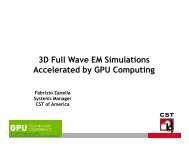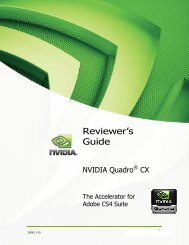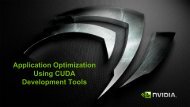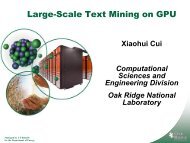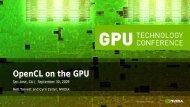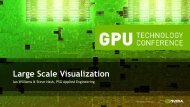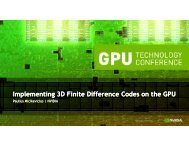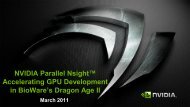Jeffrey Vetter
Jeffrey Vetter
Jeffrey Vetter
Create successful ePaper yourself
Turn your PDF publications into a flip-book with our unique Google optimized e-Paper software.
<strong>Jeffrey</strong> <strong>Vetter</strong><br />
Presented to<br />
SC09<br />
NVIDIA
Contributors<br />
• <strong>Jeffrey</strong> <strong>Vetter</strong>, Jack Dongarra,<br />
Richard Fujimoto, Thomas<br />
Schulthess, Karsten Schwan,<br />
Sudha Yalamanchili, Kathlyn<br />
Boudwin, Jim Ferguson, Doug<br />
Hudson, Patricia Kovatch, Bruce<br />
Loftis, Jeremy Meredith, Jim<br />
Rogers, Philip Roth, Arlene<br />
Washington, Phil Andrews, Mark<br />
Fahey, Don Reed, Tracy Rafferty,<br />
Ursula Henderson, Terry Moore,<br />
and many others<br />
• NVIDIA<br />
• HP<br />
19 November 2009<br />
• Keeneland Sponsor: NSF<br />
• Other sponsors: DOE,<br />
DOD, DARPA<br />
2
Overview<br />
• Predictive scientific simulation is important for<br />
scientific discovery<br />
• HPC systems have been highly successful<br />
• The HPC community has several (new) constraints<br />
• Heterogeneous computing with GPUs offers some<br />
opportunities and challenges<br />
• Newly awarded NSF partnership will provide<br />
heterogeneous supercomputing for open science<br />
– ORNL-Cray-NVIDIA announced system also using<br />
graphic processors<br />
3
SCIENTIFIC SIMULATION<br />
19 November 2009 4
Leadership computing is advancing scientific<br />
discovery<br />
Resolved decades-long<br />
controversy about modeling<br />
physics of high temperature<br />
superconducting cuprates<br />
First fully 3D plasma simulations<br />
shed new light on engineering<br />
superheated ionic gas in ITER<br />
New insights into protein<br />
structure and function leading<br />
to better understanding of<br />
cellulose-to-ethanol conversion<br />
Fundamental instability<br />
of supernova shocks discovered<br />
directly through simulation<br />
Addition of vegetation models<br />
in climate code for global,<br />
dynamic CO 2 exploration<br />
First 3-D simulation of flame that<br />
resolves chemical composition,<br />
temperature, and flow<br />
5
Jaguar XT5 science workload<br />
� Current: Transition to operations<br />
� 27 early-access projects, January–July<br />
> Total allocation: 540.8M hours<br />
> Usage since January: 247M hours (159 users)<br />
� ALCC project: FY09 Joule metric applications<br />
> Total allocation: 25M hours<br />
> Usage since January: 17M hours (17 users)<br />
� Fall 2009: General availability<br />
� 38 INCITE projects transitioned to system<br />
> Total allocation: 469M hours<br />
> Usage (XT4) since January: 91M hours (448<br />
users)<br />
� Discretionary projects: Climate AR5<br />
production<br />
> Total allocation: 80M hours<br />
> 2 projects: NCAR/DOE and NOAA (~50 users)
Highly visible science output<br />
Physical Review Letters:<br />
High temperature<br />
superconductivity<br />
Nature:<br />
Astrophysics<br />
Combustion and Flame:<br />
3D flame simulation<br />
Transformational science enabled<br />
by advanced scientific computing<br />
Physics of Plasmas:<br />
ICRF heating in ITER<br />
19 November 2009 7
Examples: Climate Modeling<br />
� Assess scientific basis,<br />
impact, adaptation,<br />
vulnerability, mitigation<br />
> Observation and simulation<br />
play critical roles<br />
� Profound impact on<br />
worldwide socioeconomic<br />
policy, energy, etc<br />
> UN Conference - Sep 09<br />
> Copenhagen Climate<br />
conference – Dec 09<br />
� Intergovernmental Panel On<br />
Climate Change<br />
> Sponsored by UNEP and WMO<br />
> Thousands of scientists from<br />
around the world<br />
http://www.ipcc.ch http://en.cop15.dk/<br />
19 November 2009 8
Application Complexity<br />
� Today’s applications are quickly<br />
becoming more complex than<br />
earlier applications<br />
> Exascale Town Hall report [1]<br />
� Increased fidelity<br />
� Answering more complex<br />
questions<br />
> Scientists [2,3] working on model<br />
that combines<br />
– Climate model<br />
– Energy economics<br />
– Population movements,<br />
demographics<br />
Source: LLNL ALE3D Team<br />
Applications design and implementation are already complex!!<br />
Writing and optimizing code for each new architecture and programming<br />
model is impractical (and only going to happen w/ heroic efforts/funding.)<br />
[1] H. Simon, T. Zacharia, and R. Stevens, Eds., Modeling and Simulation at the Exascale for Energy and the Environment, 2007.<br />
[2] S.W. Hadley, D.J. Erickson et al., “Responses of energy use to climate change: A climate modeling study,” Geophysical Research Letters, 33(17),<br />
2006.<br />
[3] D. Vergano, “Air conditioning fuels warming,” in USA Today, 2006.<br />
9
HPC LANDSCAPE TODAY<br />
JAGUAR AT ORNL<br />
19 November 2009 10
HPC Landscape Today<br />
� 2.3 PF Peak<br />
� 1.7 PF announced yesterday<br />
19 November 2009 http://nccs.gov<br />
11
Science applications are scaling on Jaguar<br />
Science area Code Contact Cores Performance<br />
Materials DCA++ Schulthess 150,144 1.3 PF MP<br />
Materials LSMS Eisenbach 149,580 1.05 PF<br />
Seismology SPECFEM3D Carrington 149,784 165 TF<br />
Weather WRF Michalakes 150,000 50 TF<br />
Climate POP Jones 18,000 20 simulation years/day<br />
Combustion S3D Chen 144,000 83 TF<br />
Fusion GTC PPPL 102,000 20 billion particles/second<br />
Materials LS3DF Lin-Wang Wang 147,456 442 TF<br />
Chemistry NWChem Apra 96,000 480 TF<br />
Chemistry MADNESS Harrison 140,000 550+ TF<br />
More apps to come in this year’s Gordon Bell contest
THE ROAD AHEAD<br />
19 November 2009 13
Representative Roadmap to Exascale from ORNL<br />
50 TF > 100 TF > 250 TF Cray XT4 (LCF-1)<br />
ORNL Multi-Agency Computer Facility<br />
260,000 ft 2<br />
2006 2007 2008 2009 2010 2011 2012 2013 2014<br />
19 November 2009<br />
18.5 TF Cray X1E<br />
(LCF- 0)<br />
0.6 -> 1 PF Cray XT(NSF- 1)<br />
1 -> 2 PF Cray (LCF-2)<br />
170 TF Cray XT4 (NSF-0)<br />
ORNL Computational Sciences Building<br />
20 PF > 40 PF<br />
ORNL Multipurpose Research Facility<br />
100 PF > 250 PF<br />
2015<br />
1 EF<br />
2016 2017<br />
14
… facilities and cost issue ???<br />
50 TF > 100 TF > 250 TF Cray XT4 (LCF-1)<br />
ORNL Multi-Agency Computer Facility<br />
260,000 ft 2<br />
2006 2007 2008 2009 2010 2011 2012 2013 2014<br />
19 November 2009<br />
18.5 TF Cray X1E<br />
(LCF- 0)<br />
0.6 -> 1 PF Cray XT(NSF- 1)<br />
1 -> 2 PF Cray (LCF-2)<br />
170 TF Cray XT4 (NSF-0)<br />
ORNL Computational Sciences Building<br />
20 PF > 40 PF<br />
ORNL Multipurpose Research Facility<br />
100 PF > 250 PF<br />
2015<br />
1 EF<br />
2016 2017<br />
?<br />
15
Reality: Facilities and Power for Exascale Computing are growing<br />
at an unsustainable rate<br />
Open Science Center (40k ft2)<br />
•Upgrading building power to 15 MW<br />
•210 MW substation, upgradeable to 280 MW<br />
•Deploying a 6,600 ton chiller plant<br />
•Tripling UPS and generator capability<br />
National Security Center (32k ft2)<br />
•Capability computing for national defence<br />
•25 MW of power and 8,000+ ton chillers<br />
New Computer Facility (260k ft2)<br />
•110 ft2 raised floor classified; same unclassified<br />
•Shared mechanical and electrical<br />
•Lights out facility<br />
•Capable of greater than 100 MW power<br />
19 November 2009 16
17<br />
Power, cooling, and floorspace are fundamental challenges for<br />
the entire community over the next decade<br />
� Energy, Power, and Facilities<br />
> Exascale system cannot use 1 GW!!<br />
> Can we do Exascale in 20 MW??<br />
� Memory and Storage<br />
� Concurrency and Locality<br />
� Resiliency
Decisions for Managing Power and<br />
Facilities Demands<br />
� Build bigger buildings near<br />
power stations, and allocate<br />
large budget for power<br />
� Improve efficiencies<br />
> Power distribution<br />
> Workload scheduling<br />
> Software<br />
� Design new underlying<br />
technologies<br />
> Optical networks<br />
> 3D stacking<br />
> MRAM, PCM, nanotubes<br />
� Use different architectures<br />
(that match your workload)<br />
� Or, build bigger buildings and plan<br />
to pay $$$ for ops<br />
18
Scaling dimension seems straightforward …<br />
4…<br />
80…<br />
160…<br />
240 cores, 30k threads…<br />
19
Another dimension:<br />
Several Factors Motivate Heterogeneity<br />
� Sacrifice generality and<br />
compatibility to address specific<br />
algorithms<br />
� Computational power<br />
> Asymmetric, dynamic cores can<br />
provide performance advantages<br />
[1]<br />
> Use transistors differently<br />
� Tukwila – First 2 billion transistor<br />
chip<br />
> 80486 had ~1.2M transistors,<br />
~50MHz, 1989<br />
> Specialization can be free<br />
� Power<br />
> Combination of these features<br />
provide more ops per watt for<br />
your targeted application<br />
� Memory<br />
> Include different cache or<br />
memory organization tuned for<br />
data access patterns<br />
� Performance of general purpose<br />
processors de-accelerating<br />
ISSCC 2008.<br />
[1] M.D. Hill and M.R. Marty, “Amdahl's Law in the Multicore Era,” IEEE Computer, to appear, 2008.<br />
20
ENABLING HETEROGENEOUS<br />
COMPUTING FOR THE OPEN<br />
SCIENCE COMMUNITY<br />
19 November 2009 21
National Science Foundation Office of<br />
Cyberinfrastructure<br />
• NSF OCI HPC Strategy<br />
– Track 1, BlueWaters<br />
– Track 2, TACC Ranger, NICS Kraken<br />
• NSF 08-573 OCI Track 2D RFP in Fall 2008<br />
– Data Intensive<br />
– Experimental Grid testbed<br />
– Pool of loosely coupled grid-computing resources<br />
– Experimental HPC System of Innovative Design<br />
22
Large Scale Computational Science Demands Performance,<br />
Programmability, Precision, Reliability, Cost from HPC<br />
Platforms<br />
• Performance<br />
– Must show reasonable performance improvements at scale on real<br />
scientific applications of interest<br />
• Programmability<br />
– Must be easy to re-port and re-optimize applications for each new<br />
architecture (generation) without large effort, delays<br />
• Precision - Accuracy<br />
– Must provide impressive performance accurately<br />
• Reliability<br />
– Must get high scientific throughput without job failures or inaccurate<br />
results<br />
• Power and Facilities Cost<br />
– Must be reasonably affordable in terms of power and facilities costs
Oct 2008 – Alternatives Analysis<br />
• STI Cell<br />
• FGPAs<br />
• Cyclops64<br />
• Cray XMT<br />
• Sun Rock/Niagara<br />
• ClearSpeed<br />
• Tensilica<br />
• Tilera<br />
• Anton<br />
• SGI Molecule<br />
• Intel Larrabee<br />
• Graphics processors<br />
• Others…<br />
24
Alternatives analysis concluded GPUs<br />
were a competitive solution<br />
• Success with various applications<br />
at DOE, NSF, government,<br />
industry<br />
– Signal processing, image<br />
processing, etc.<br />
– DCA++, S3D, NAMD, many others<br />
• Commodity solution<br />
• Certified GPGPU clusters widely<br />
available this past quarter from<br />
multiple vendors<br />
• Improving programmability<br />
– Widespread adoption of CUDA<br />
– OpenCL ratification<br />
• Community application<br />
experiences also positive<br />
– Frequent workshops, tutorials,<br />
software development, university<br />
classes<br />
– Many apps teams are excited about<br />
using GPGPUs<br />
• NVIDIA GT200 - 240<br />
“cores”<br />
25
GPU Rationale – What’s different now?<br />
High SP<br />
Flop Rate<br />
Leverage<br />
commodity<br />
19 November 2009<br />
Very High<br />
Memory<br />
Bandwidth<br />
High Flop<br />
per Watt<br />
Heterogeneous<br />
Computing<br />
with Graphics<br />
Processors<br />
Productivity<br />
CUDA<br />
OpenCL<br />
Reliability at<br />
Scale<br />
Fermi<br />
High DP<br />
Flop Rate<br />
26
GPU Rationale - Power Efficiency!<br />
FERM<br />
I TBA<br />
Source: http://www.realworldtech.com
Keeneland – An NSF-Funded Partnership to Enable Large-scale<br />
Computational Science on Heterogeneous Architectures<br />
• Track 2D System of Innovative Design<br />
– Large GPU cluster<br />
– Initial delivery system – Spring 2010<br />
– Full scale system – Spring 2012<br />
• Software tools, application<br />
development<br />
• Operations, user support<br />
• Education, Outreach, Training for<br />
scientists, students, industry<br />
<strong>Jeffrey</strong> <strong>Vetter</strong><br />
Jack Dongarra<br />
Richard Fujimoto<br />
Thomas Schulthess<br />
Karsten Schwan<br />
Sudha Yalamanchili<br />
Kathlyn Boudwin<br />
Jim Ferguson<br />
Doug Hudson<br />
Patricia Kovatch<br />
Bruce Loftis<br />
Jeremy Meredith<br />
Jim Rogers<br />
Philip Roth<br />
Arlene Washington<br />
Phil Andrews<br />
Mark Fahey<br />
Don Reed<br />
Tracy Rafferty<br />
Ursula Henderson<br />
Terry Moore<br />
28
Keeneland Partners<br />
Georgia<br />
Institute of<br />
Technology<br />
Project<br />
management<br />
Acquisition and<br />
alternatives<br />
assessment<br />
System<br />
software and<br />
development<br />
tools<br />
Education,<br />
Outreach,<br />
Training<br />
UT National<br />
Institute of<br />
Computational<br />
Sciences<br />
Operations and<br />
TG/XD<br />
Integration<br />
User and<br />
Application<br />
Support<br />
Operational<br />
Infrastructure<br />
Education,<br />
Outreach,<br />
Training<br />
Oak Ridge<br />
National<br />
Laboratory<br />
Applications<br />
Facilities<br />
Education,<br />
Outreach,<br />
Training<br />
University of<br />
Tennessee,<br />
Knoxville<br />
Scientific<br />
Libraries<br />
Education,<br />
Outreach,<br />
Training<br />
NVIDIA<br />
Tesla<br />
Applications<br />
optimizations<br />
Training<br />
HP<br />
HPC Host<br />
System<br />
System<br />
integration<br />
Training<br />
29
Keeneland Initial Delivery (ID) System<br />
• Hewlett Packard Nodes<br />
– Dual socket Intel 2.8 GHz<br />
Nehalem-EP<br />
– 24 GB Main memory per node<br />
• NVIDIA Servers<br />
– Fermi GPUs<br />
• InfiniBand 4x QDR w/ full<br />
bisection interconnect<br />
• Traditional Linux software<br />
stack augmented with GPU<br />
compilers, software tools,<br />
libraries<br />
• Hundreds of Fermi processors<br />
• Delivery and acceptance in<br />
Spring 2010<br />
30
ID system will use NVIDIA’s Fermi<br />
• “The soul of a supercomputer in the<br />
body of a GPU.”<br />
• 3B transistors<br />
• ECC<br />
• 8x the peak double precision<br />
arithmetic performance over NVIDIA's<br />
last generation GPU.<br />
• 512 CUDA Cores featuring<br />
the new IEEE 754-2008<br />
floating-point standard<br />
• NVIDIA Parallel DataCache<br />
• NVIDIA GigaThread Engine<br />
• CUDA and OpenCL support<br />
• Debuggers, language support<br />
31
APPLICATIONS<br />
32
Computational Materials - Case Study<br />
• Quantum Monte Carlo simulation<br />
– High-temperature superconductivity<br />
and other materials science<br />
– 2008 Gordon Bell Prize<br />
• GPU acceleration speedup of 19x in main<br />
QMC Update routine<br />
– Single precision for CPU and GPU:<br />
target single-precision only cards<br />
– Required detailed accuracy study and<br />
mixed precision port of app<br />
• Full parallel app is 5x faster, start to finish,<br />
on a GPU-enabled cluster<br />
GPU study: J.S. Meredith, G. Alvarez, T.A. Maier, T.C. Schulthess, J.S. <strong>Vetter</strong>,<br />
“Accuracy and Performance of Graphics Processors: A Quantum Monte<br />
Carlo Application Case Study”, Parallel Comput., 35(3):151-63, 2009.<br />
Accuracy study: G. Alvarez, M.S. Summers, D.E. Maxwell, M. Eisenbach, J.S.<br />
Meredith, J. M. Larkin, J. Levesque, T. A. Maier, P.R.C. Kent, E.F.<br />
D'Azevedo, T.C. Schulthess, “New algorithm to enable 400+ TFlop/s<br />
sustained performance in simulations of disorder effects in high-Tc<br />
superconductors”, SuperComputing, 2008. [Gordon Bell Prize winner]<br />
10000 seconds<br />
1000 seconds<br />
100 seconds<br />
10 seconds<br />
1 seconds<br />
CPU Runtime<br />
GPU Runtime<br />
4 8 12 16 20 24<br />
33
Combustion with S3D – Case Study<br />
• Application for combustion - S3D<br />
– Massively parallel direct numerical<br />
solver (DNS) for the full compressible<br />
Navier-Stokes, total energy, species<br />
and mass continuity equations<br />
– Coupled with detailed chemistry<br />
– Scales to 150k cores on Jaguar<br />
• Accelerated version of S3D’s<br />
Getrates kernel in CUDA<br />
– 14.3x SP speedup<br />
– 9.32x DP speedup<br />
K. Spafford, J. Meredith, J. S. <strong>Vetter</strong>, J. Chen, R. Grout, and R. Sankaran.<br />
Accelerating S3D: A GPGPU Case Study. Proceedings of the Seventh<br />
International Workshop on Algorithms, Models, and Tools for Parallel<br />
Computing on Heterogeneous Platforms (HeteroPar 2009) Delft, The<br />
Netherlands.<br />
34
Biomolecular systems from NAMD Team –<br />
Not just us<br />
• NAMD, VMD<br />
– Study of the structure and<br />
function of biological molecules<br />
• Calculation of non-bonded forces<br />
on GPUs leads to 9x speedup<br />
• Framework hides most of the GPU<br />
complexity from users<br />
J.C. Phillips and J.E. Stone, “Probing biomolecular<br />
machines with graphics processors,” Commun.<br />
ACM, 52(10):34-41, 2009. (fig)<br />
35
KEENELAND SOFTWARE<br />
36
Keeneland Software Environment<br />
• Integrated with NSF<br />
TeraGrid/XD<br />
– Including TG and NICS<br />
software stack<br />
• Programming models<br />
– CUDA<br />
– OpenCL<br />
– PGI w/ accelerate<br />
– OpenMP 3.0<br />
– MPI<br />
• Additional software<br />
activities<br />
– Performance and<br />
correctness tools<br />
– Scientific libraries<br />
– Virtualization<br />
– Benchmarks<br />
37
Ocelot: Dynamic Execution Infrastructure<br />
NVIDIA Virtual ISA<br />
Use as a basis for<br />
– Insight � workload characterization<br />
– Performance tuning � detecting memory bank conflicts<br />
– Debugging � illegal memory accesses, out of bounds checks, etc.<br />
PTX 1.4 compliant Emulation<br />
• Validated on full CUDA SDK<br />
• Open Source version released<br />
http://code.google.com/p/gpuocelot<br />
/<br />
Gregory Diamos, Dhuv<br />
Choudhary, Andrew Kerr,<br />
Sudhakar Yalamanchili<br />
Gregory Diamos recently awarded<br />
NVIDIA Fellowship<br />
38
Workload Analysis: Examples<br />
Branch Divergence<br />
• Study of control Flow<br />
behavior<br />
• Motivate<br />
synchronization support<br />
39<br />
Inter-thread Data Flow<br />
• Study of data sharing<br />
patterns<br />
• Motivate architectural<br />
support<br />
Gregory Diamos, Dhuv<br />
Choudhary, Andrew Kerr,<br />
Sudhakar Yalamanchili
One and two-sided Multicore+GPU Factorizations<br />
• These will be included in up-coming MAGMA releases<br />
• Two-sided factorizations can not be efficiently accelerated on homogeneous x86-based<br />
multicores (above) because of memory-bound operations<br />
- MAGMA provided hybrid algorithms that overcome those bottlenecks (16x speedup!)<br />
Multicore + GPU Performance in double precision<br />
GFlop / s<br />
LU Factorization Hessenberg Factorization<br />
100<br />
50<br />
80<br />
60<br />
40<br />
20<br />
Multicore + GPU<br />
One core + GPU<br />
Multicore<br />
One core<br />
0<br />
1 2 3 4 5 6 7 8 10<br />
Matrix size x 1000<br />
40<br />
30<br />
20<br />
10<br />
Multicore + GPU<br />
One core + GPU<br />
Multicore<br />
One core<br />
0<br />
1 2 3 4 5 6 7 8<br />
Matrix size x 1000<br />
Jack<br />
Dongarra,<br />
Stan Tomov,<br />
and Rajib<br />
Nath<br />
GPU : NVIDIA GeForce GTX 280 GPU BLAS : CUBLAS 2.2, dgemm peak: 75 GFlop/s<br />
CPU : Intel Xeon dual socket quad-core @2.33 GHz CPU BLAS : MKL 10.0 , dgemm peak: 65 GFlop/s<br />
40
Scalable Heterogeneous Computing<br />
(SHOC) Benchmark Suite<br />
• Problem: we don’t yet understand overheads<br />
and performance benefits of GPU versus CPU,<br />
and trade-offs between different<br />
programming approaches<br />
– Systems can differ greatly<br />
– Need procurement and acceptance tests<br />
• Antero: a collection of benchmark programs<br />
for quantifying those overheads and tradeoffs<br />
• Multiple levels<br />
– Level 0: low-level, feeds and speeds<br />
– Level 1: higher-level, problem kernels<br />
• Multiple test categories<br />
– Performance<br />
– Stability<br />
• Support for both single-node and clusters like<br />
Keeneland (MPI-based) Jeremy Meredith, Phil Roth, Kyle Spafford,<br />
Anthony Danalis, Gabriel Marin, Vinod<br />
Tipparaju, <strong>Jeffrey</strong> <strong>Vetter</strong>
Summary<br />
• Predictive scientific simulation is important for scientific<br />
discovery<br />
– Advancing science, informing policymakers<br />
• HPC systems have been highly successful<br />
– Decades of improvement<br />
• The HPC community has several (new) constraints<br />
– Power, Facilities, Cost<br />
• Heterogeneous computing with GPUs offers some<br />
opportunities and challenges<br />
– High performance; good performance per watt<br />
– Programmability; limited applicability<br />
• Keeneland - Newly awarded NSF partnership will provide<br />
heterogeneous supercomputing for open science
Thank You!<br />
Thanks to contributors, sponsors<br />
Many collaborators across apps<br />
teams, academia, labs, and<br />
industry<br />
DOE, NSF, ORNL, DARPA, DOD<br />
More information<br />
http://ft.ornl.gov<br />
vetter@computer.org<br />
Publications: http://ft.ornl.gov/pubs<br />
http://keeneland.gatech.edu<br />
http://www.cse.gatech.edu<br />
http://www.cercs.gatech.edu<br />
http://icl.cs.utk.edu<br />
http://www.nics.tennessee.edu/<br />
http://ft.ornl.gov<br />
http://nsf.gov/dir/index.jsp?org=OCI<br />
19 November 2009 43


